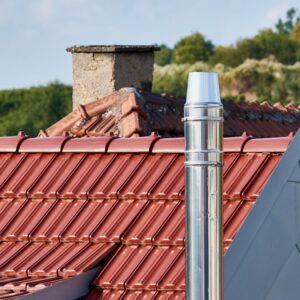A chimney is so much more than just a decorative element in your home, despite the character its brick or stone may bring. It serves a crucial purpose in ensuring the safe and efficient functioning of your fireplace or heating appliance too. And one of the key components that helps ensure functioning is the chimney liner.
Your chimney liner may be out of sight – and out of mind – but it’s essential for home safety and the longevity of your chimney system. Over time, chimney liners can deteriorate, leading to potential dangers and accelerated overall system deterioration.
Fortunately, we can help. For chimney repair and relining services in Siskiyou County, trust us for it all.
What Does My Chimney Liner Do?
 A chimney liner is the clay tile or metal passageway that protects the interior walls of your chimney from a host of things that could cause damage – things like heat, moisture, and the byproducts of combustion. If your liner is compromised, your chimney is much more vulnerable to damage – and this can create hazards and lead to expensive repairs down the road.
A chimney liner is the clay tile or metal passageway that protects the interior walls of your chimney from a host of things that could cause damage – things like heat, moisture, and the byproducts of combustion. If your liner is compromised, your chimney is much more vulnerable to damage – and this can create hazards and lead to expensive repairs down the road.
Since much of your chimney liner is hidden from view, it’s important to take proactive steps to ensure that it’s in good working condition. Ultimately, the only way to get an accurate assessment on the condition of your chimney liner is to have your chimney professionally inspected.
Your chimney should be inspected annually by a certified pro, whether you’ve used it daily or scarcely at all the preceding year. Inspections can call attention to issues that can be difficult to identify without specialized tools and training since many areas of your chimney are challenging to access – and they can bring these issues to light while they are less severe and more readily (and inexpensively) resolved.
Indicators of Chimney Liner Deterioration
While a chimney inspection is the best way to know how your chimney liner is holding up, there are some telltale issues that indicate that your chimney liner may need to be replaced. If you notice any of these signs, however, it’s likely that the deterioration is already quite advanced, so don’t hesitate to call a professional chimney technician right away.
 Flaking debris: Have you noticed bits of tile or clay material in your fireplace? This is a strong sign that your chimney liner is breaking down. As the liner deteriorates, these pieces may flake off and fall into your fireplace and stove. If your liner is flaking apart, there will be weak spots where your chimney walls or the interior framing of your home may be exposed to high heat and damaging combustion byproducts.
Flaking debris: Have you noticed bits of tile or clay material in your fireplace? This is a strong sign that your chimney liner is breaking down. As the liner deteriorates, these pieces may flake off and fall into your fireplace and stove. If your liner is flaking apart, there will be weak spots where your chimney walls or the interior framing of your home may be exposed to high heat and damaging combustion byproducts.- Smoke inside your home: Your chimney system is designed to vent smoke and gases safely outside of your home. It’s alarming to see smoke or soot inside your home, and if you do, chimney liner damage may be at play. Smoke, creosote, and gases (such as carbon monoxide) should never be in your living spaces because they pose significant health and safety risks and can damage your home.
- Increased draft problems: Similarly, a damaged chimney liner can disrupt proper drafting of your stove or fireplace. Have you noticed difficulty starting a fire, frequent backdrafts, or lessened efficiency? If you’ve tried to remedy the situation, but it persists, it may be time to investigate the chimney liner as a potential contributor.
- Cracking and gaps: Over time, chimney liners can develop cracks or gaps. These openings can give heat, flames, and corrosive gases an open pathway to the interior masonry of your chimney. If you notice visible damage to your interior liner, it’s time to consult a chimney professional about replacement.
- Rust or corrosion: If your chimney liner is metal, you may notice rust or corrosion, which indicate that your liner is in disrepair.
- Water leaks: Moisture in your chimney can be very damaging to the structure. If you notice water leaks or staining on your walls or ceiling near the chimney, your liner may be compromised.
A damaged chimney liner may no longer be safely containing high heat, smoke, and carbon monoxide and venting it outside your home. While these indicators can help you recognize liner issues, the only way to know for sure if replacement is necessary is by having a thorough assessment of the chimney system.
Taking this step will help ensure that any issues with your liner are accurately identified, and that appropriate measures will be taken to address them. Reasonably quick and affordable, chimney inspections are an important investment in your home.
How Often Does a Chimney Need To Be Relined?
Chimney liners have a pretty long lifespan – on average 15 – 20 years. But if your liner is in need of attention your inspector may recommend either the appropriate level of repair or complete replacement, depending on the severity of the liner’s condition.
For Fireplace & Chimney Repairs, Turn to Us
If it’s time for a new chimney liner, our certified chimney reliners bring high level expertise to the task. We have training, experience, and customer safety in mind every time we set to work. We use stainless steel insulated liners that are top notch when it comes to efficiency and safety.
Stainless steel liners are highly resistant to corrosion, rust, and heat, lending themselves to longevity and performance. They work for appliances with all types of fuel sources, and when professionally installed the manufacturers guarantee them for a lifetime.
Give us a call at 530-285-3841 or reach out to us online now to get started.

Recent Comments